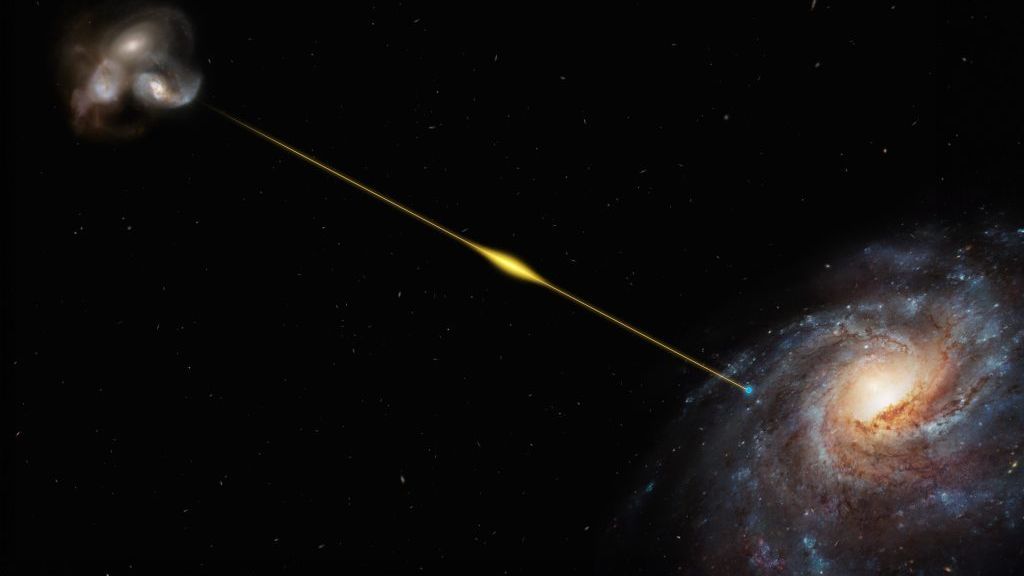
Ancient, Distant Signal From Space Offers Insight Into Universe’s Weight
Artist's impression (not to scale) illustrates the path of the fast radio burst FRB 20220610A, from the distant galaxy where it originated all the way to Earth. PHOTO BY M.KORNMESSER/SWNS
|
Getting your Trinity Audio player ready...
|
The most ancient and distant signal from outer space has been identified, dating back EIGHT BILLION YEARS.
The record-breaking fast radio burst, or FRB, offers a way of weighing the entire universe, say scientists.
First discovered in 2007, fast radio bursts last only a millisecond.
Some experts have suggested they may be from an extraterrestrial life form trying to contact Earth.
However, the exact cause and origins of FRBs still remain unconfirmed.

Now, in a paper published in the journal Science, a global team led by Australian researchers has revealed the discovery of the most ancient and distant fast radio burst located to date.
The discovery smashes the team’s previous record by 50 percent.
They say it confirms that fast radio bursts (FRBs) can be used to measure the “missing” matter between galaxies.
The source of the burst was shown to be a group of two or three galaxies that are merging, supporting current theories on the cause of fast radio bursts.
The research also showed that eight billion years is about as far back as we can expect to see and pinpoint fast radio bursts with current telescopes.
The ASKAP radio telescope on Wajarri Yamaji Country in Western Australia was used to detect a fast radio burst, created in a cosmic event that released, in milliseconds, the equivalent of our Sun’s total emission over 30 years.

Study first author Macquarie University’s Dr Stuart Ryder, of Macquarie University, said: “Using ASKAP’s array of dishes, we were able to determine precisely where the burst came from.
“Then we used the European Southern Observatory (ESO) Very Large Telescope (VLT) in Chile to search for the source galaxy, finding it to be older and further away than any other FRB source found to date, and likely within a small group of merging galaxies.”
Named FRB 20220610A, he said the fast radio burst has reaffirmed the concept of weighing the Universe using data from FRBs which was first demonstrated by the late Australian astronomer Jean-Pierre ‘J-P’ Macquart in a paper in the journal Nature in 2020.
Professor Ryan Shannon, of Swinburne University of Technology, said: “J-P showed that the further away a fast radio burst is, the more diffuse gas it reveals between the galaxies.
“This is now known as the Macquart relation. Some recent fast radio bursts appeared to break this relationship.
“Our measurements confirm the Macquart relation holds out to beyond half the known Universe.”
About 50 FRBs have been pinpointed to date – nearly half using ASKAP.
The research team suggests we should be able to detect thousands of them across the sky, and at even greater distances.
Shannon said: “While we still don’t know what causes these massive bursts of energy, the paper confirms that fast radio bursts are common events in the cosmos and that we will be able to use them to detect matter between galaxies, and better understand the structure of the Universe.”
ASKAP is currently the best radio telescope to detect and locate FRBs.
The research team said that international SKA telescopes now under construction in Western Australia and South Africa will be even better at allowing astronomers to locate even older and more distant FRBs.
The nearly 40-metre mirror of ESO’s Extremely Large Telescope, currently under construction in the high, dry Chilean desert will then be needed to study their source galaxies.
The project also includes researchers from the SKA Observatory in the UK plus scientists at Northwestern University, UC Berkeley, and UC Santa Cruz in the USA.
However, the team said current methods of estimating the mass of the Universe are giving conflicting answers and challenging the standard model of cosmology.
Shannon said: “If we count up the amount of normal matter in the Universe – the atoms that we are all made of – we find that more than half of what should be there today is missing.
“We think that the missing matter is hiding in the space between galaxies, but it may just be so hot and diffuse that it’s impossible to see using normal techniques.”
He added: “Fast radio bursts sense this ionised material.
“Even in space that is nearly perfectly empty they can ‘see’ all the electrons, and that allows us to measure how much stuff is between the galaxies.”
Produced in association with SWNS Talker
“What’s the latest with Florida Man?”
Get news, handpicked just for you, in your box.



